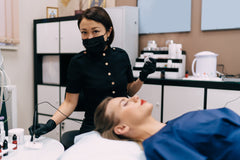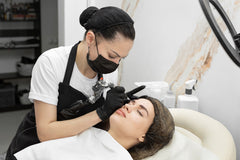📦 Free Shipping for orders of $300 or more. USPS Priority Mail Express days only applies when ordered before 1:00 pm California time. 🔷 Become a BC Member and receive free shipping on all orders no minimums! Free shipping is only offered to USA and Puerto Rico orders. Learn More >> 🔷
📦 Free Shipping for orders of $300 or more. USPS Priority Mail Express days only applies when ordered before 1:00 pm California time. 🔷 Become a BC Member and receive free shipping on all orders no minimums! Free shipping is only offered to USA and Puerto Rico orders. Learn More >> 🔷
The Science Behind PMU Pigments: What Artists Must...

The Science Behind Permanent Makeup Pigments: A Guide for PMU Professionals
- Media BC
- -
- Jun, 09 , 25
Permanent makeup (PMU) has evolved into a sophisticated beauty solution, and at its heart are pigments—the unsung heroes that define color, longevity, and satisfaction in results. For permanent makeup artists and salon owners, understanding the science behind pigments is not just beneficial, it's essential.
What Are Permanent Makeup Pigments?

PMU pigments are specially formulated colorants used for cosmetic tattooing procedures like eyebrows, eyeliner, and lip tinting. Unlike traditional tattoo inks, PMU pigments are designed to fade naturally over time, aligning with the evolving preferences of clients and advancements in pigment technology.
Composition of PMU Pigments
Most PMU pigments fall into two categories: organic and inorganic.
-
Organic pigments are carbon-based and offer vibrant, long-lasting colors, ideal for clients wanting a more intense result.
-
Inorganic pigments, often mineral-based, produce softer hues and are favored for their natural look and low allergenic potential.
The best pigments balance safety, performance, and beauty, adhering to strict cosmetic-grade manufacturing standards.
For a more in depth look at these types of pigments read our past blog:
Pigments in Micropigmentation: Organic, Inorganic, or Hybrid?
A Note on Color Theory

Color theory is crucial in pigment selection, but we've covered it in detail in another post. For an in-depth look, check out our blog on PMU color theory.
Factors Affecting Pigment Retention
Several factors influence how well pigments retain in the skin:

Skin type: Oily skin may blur and fade pigments faster.

Aftercare: Proper healing protocols significantly improve pigment longevity.

Sun exposure: UV rays can break down pigment molecules, leading to quicker fading.
Educating clients on aftercare is as crucial as the procedure itself.
Choosing the Right Pigments for Your Clients
Different PMU procedures demand tailored pigment choices:
Brows: Soft browns and taupes are popular, but must be matched with skin tone and hair color.
Lips: Coral, rose, and natural pinks enhance natural lip tones.
Eyeliner: Carbon black or soft charcoal are standard, with color additives for customization.
Our premium pigment line offers high-quality, easy-to-implant formulas with consistent results. Browse our pigment selection to find your perfect match.
Safety and Best Practices
- Always perform a patch test to rule out allergic reactions.
- Store pigments in a cool, dry place away from direct sunlight.
- Check for expiration dates and use pigments within recommended timeframes.
Stay updated with industry regulations to ensure compliance and client safety.

Mastering the science behind permanent makeup pigments empowers professionals to deliver stunning, safe, and long-lasting results. By choosing the right pigments and understanding their behavior, you elevate your artistry and client satisfaction.
Ready to transform your PMU services? Explore our top-rated pigments designed for professionals who demand excellence. Shop Now
← Older Post Newer Post →
Search
Recent Post
From Studio to Pe...
Nov 12, 2025Color Correction ...
Oct 15, 2025Permanent Makeup ...
Sep 05, 2025Archive
- September 2025
- April 2025
- February 2025
Tags
Custom Menu
Added to cart successfully!
FROM_JS
Compare Product
Countdown message










